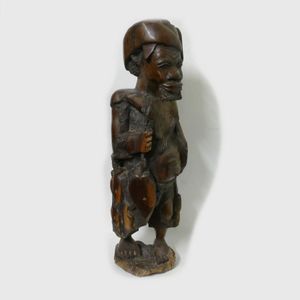Shishimai Dancer Ivory Netsuke
You must be a subscriber, and be logged in to view price and dealer details.
Subscribe Now to view actual auction price for this item
When you subscribe, you have the option of setting the currency in which to display prices to $Au, $US, $NZ or Stg.
- Lion Mask - The lion mask has been used for centuries in various forms of art and design, including furniture, silver, and ceramics, and is usually y depicted as a stylized representation of the face of a lion, often with an open mouth and protruding tongue. and is often used as a handle, knob, or other decorative element.
In furniture design, lion masks were popular in the neoclassical and Empire styles of the late 18th and early 19th centuries. They were often used as decorative elements on the legs or arms of chairs, as well as on cabinet and drawer pulls. It was also used as a handle, knob, or other decorative element.
In silverware design, lion masks were often applied to tea and coffee pots, as well as on candlesticks, snuff boxes, and other small silver items. The lion mask was often used in combination with other neoclassical motifs, such as laurel wreaths or acanthus leaves, to create a sense of grandeur and classical elegance.
In ceramics, lion masks were often depicted in relief, and were sometimes used in combination with other decorative elements, such as garlands or swags. - Ivory - Ivory is a hard white material that comes from the tusks of elephants, mammoth, walrus and boar, or from the teeth of hippopotamus and whales. The ivory from the African elephant is the most prized source of ivory. Although the mammoth is extinct, tusks are still being unearthed in Russia and offered for sale.
Ivory has been used since the earliest times as a material for sculpture of small items, both in Europe and the east, principally China and Japan.
In Asia ivory has been carved for netsuke, seals, okimono, card cases, fan supports, animals and other figures and even as carved tusks.
In the last 200 years in Europe ivory has been used to carve figures, for elaborate tankards, snuff boxes, cane handles, embroidery and sewing accessories, in jewellery and as inlay on furniture. Its more practical uses include being used for billiard balls, buttons, and a veneers on the top of piano keys.
The use and trade of elephant ivory have become controversial because they have contributed to Due to the decline in elephant populations because of the trade in ivory, the Asian elephant was placed on Appendix One of the Convention on International Trade in Endangered Species (CITES), in 1975, and in January 1990, the African elephant was similarly listed. Under Appendix One, international trade in Asian or African elephant ivory between member countries is forbidden. Unlike trade in elephant tusks, trade in mammoth tusks is legal.
Since the invention of plastics, there have been many attempts to create an artificial ivory
This item has been included into following indexes:
Visually similar items

A Japanese small ivory okimono, of a child clambering on the shoulders of a man. Signed. Height 5.7 cm. Repairs to wrists. Provenance: The Flower Family Collection.

An African heavy carved ebony hardwood sculpture of a fisherman, the traditional tribesman with catch. Height 75 cm

A 19th century ivory netsuke, of a yamabushi (warrior priest) sheltered beneath a pine tree with a woman. Signed. Repaired left hand. Height 5.1 cm. Provenance: The Flower Family Collection.

Antique Japanese ivory netsuke - Man with Axe, C1920, 3.5 cm high
